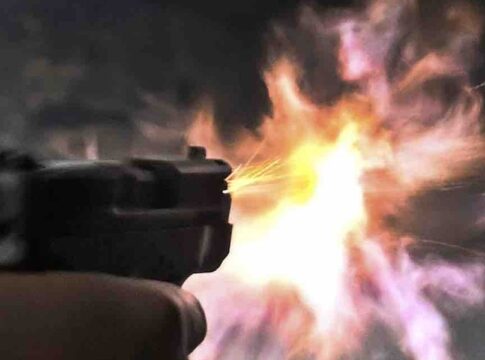Almost everybody dies — violently — in “The Texas Chainsaw Massacre.”
But, against all odds, the classic horror movie is still alive and kicking, cutting, slicing and bashing 50 years later.
The 1974 film, directed by Tobe Hooper, was made on a shoestring budget of $140,000. And critics were not so taken with the cannibalistic nightmare when it hit cinemas on Oct. 1, 1974.
The Post’s Archer Winsten hacked at the sick flick with his own chainsaw.
“If there is any justice at all,” he wrote in this newspaper, “‘The Texas Chainsaw Massacre,’ now at showcase theaters, will win a swift kick as the worst picture of 1974, quite possibly the worst of the entire ‘70s.”
So much for justice. The movie grossed a massive $25.6 million its first year at the box office and this week was named by Variety as the best horror film ever made.
Even more remarkable is that “Texas Chainsaw” was created by a group of young, inexperienced filmmakers and actors who were frequently high on pot, over-budget and laissez-faire about personal safety.
“I had no idea how dangerous the chain saw really was,” wrote Leatherface actor Gunnar Hansen in his 2013 memoir “Chain Saw Confidential: How We Made The World’s Most Notorious Horror Movie.”
“I had never used one before.”
Hansen’s Leatherface was, of course, part of a family of murderous psychopaths who terrorize a group of five teenagers in a remote part of the Lone Star State.
The creepy character wears masks made out of (fake) human skin. Ed Gein, the 1950s Wisconsin serial killer who inspired “Psycho” and “The Silence of the Lambs,” was, to a lesser extent, the basis for him.
But Leatherface has no lines or obviously playable traits.
Hansen, however, knew the script called for him to squeal like a pig. So the actor did his homework. He drove to his friend’s farm to survey the swine.
“At first I tried yelling, but I got no response,” he said. “I tried squealing, myself. They did not care. So I climbed in and chased them around the pen.”
“I finally grabbed a long stick and started prodding. I got one of the pigs so irritated that he started to squeal.”
That early porky exercise would set the tone of the entire production.
On set, strange happenings began straightaway. When the cast and crew first arrived at the chain saw house, the homeowner informed them of his illegal gardening habit.
“I guess I’d better tell you what’s going on,” he said to cinematographer Daniel Pearl. “I’ve got two acres of marijuana growing out back. So I’m telling you guys now, you can feel free to pick and dry whatever you might want for your personal consumption.”
In Texas at the time, marijuana possession was a felony.
But the team couldn’t care less. They puffed away and baked it into brownies.
John Dugan, who played Grandpa Sawyer, told Hansen: “There was a rule we weren’t supposed to smoke on the set, but…”
If viewers are spooked by the reality of the ritualistic torture rooms in the Sawyer house, it’s because a lot of what’s onscreen is the genuine article.
The dead armadillo at the start of the movie is an actual corpse that they stuffed. The filmmakers also tried out a dog and a horse, but they were too off-putting.
For the displayed bones, “we used parts of eight cows, two dogs, a cat, two deer, three goats, two real human skeletons, one chicken and an armadillo,” art director Robert A. Burns said in an interview at the time. “There were only about ten plastic bones in the whole set.”
The human skeletons, cheaper than fakes, were purchased from India.
And what about those gruesome murders that have traumatized viewers for a half century?
They were practically an arts and craft project.
One of the few scenes with heavy blood spatter is when Sally (Marilyn Burns) is pushing her wheelchair-bound brother Franklin (Paul Partain) down a hill when they’re accosted by Leatherface.
The messy effect was achieved through a bona fide spit take.
“Tobe crouched on Paul’s right with a cup of Bob’s stage blood — Karo syrup and food coloring — in his hand. Dottie Pearl did the same on the left,” Hansen wrote. “Then, as I slashed, they took mouthfuls of blood and spit it at me.”
“Tobe and Dottie Pearl spitting blood,” Marilyn joked to Hansen. “Talk about million dollar special effects!”
But sometimes the stunts weren’t silly at all — they were downright dangerous.
Leatherface’s first kill — the brutal head bashing of Kirk (William Vail), who writhes on the floor before being dragged away — was not entirely simulated.
While the hammer was a hard foam, Hansen was not actually supposed to nail Vail’s noggin. However, things did not go as planned.
“I was completely charged up on adrenaline,” Hansen wrote. “So when Bill tripped and I stepped out of the shadows, I actually hit him in the face with the sledgehammer.”
Vail kept going and horrifyingly convulsed on the ground, as is seen in the final film. But Hansen was not done yet.
“I finished him off — not a direct blow this time — and picked him up to drag him out of the way.”
The overexcited actor instead tossed Vail headfirst into a wall.
Mortified, production manager Ron Bozeman sprinted to check on Vail.
“‘Are you okay? Are you okay?’ the injured actor remembered Bozeman saying. “He just saw the whole movie coming to an end because I had been crippled and I was going to sue, and I’ve broken my neck.”
Vail was beaten up, but fine.
“Poor Bill was semiconscious,” Hansen, who died in 2015, wrote. “But on-screen the whole thing looks great.”




